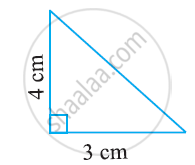Advertisements
Advertisements
Question
Show that the following points are collinear:
A(8,1), B(3, -4) and C(2, -5)
Solution
`"Let" A(x_1=8,y_1=1), B (x_2=3, y_2=-4) and C (x_3 = 2, y_3=-5) ` be the given points.
Now `x_1(y_2-y_3)+x_2(y_3-y_1)+x_3(y_1-y_2)`
=8 (-4+5) +3 (-5-1) +2(1+4)
= 8 - 18 + 10
=0
Hence, the given points are collinear.
APPEARS IN
RELATED QUESTIONS
Find the area of the quadrilateral whose vertices, taken in order, are (-4, -2), (-3, -5), (3, -2) and (2, 3).
Find the area of the following triangle:

ΔABC is right angled at A (see the given figure). AD is perpendicular to BC. If AB = 5 cm, BC = 13 cm and AC = 12 cm, Find the area of ΔABC. Also find the length of AD.

Find the area of a triangle whose sides are 9 cm, 12 cm and 15 cm ?
In a ΔABC, AB = 15 cm, BC = 13 cm and AC = 14 cm. Find the area of ΔABC and hence its altitude on AC ?
Show that the points A (3,1) , B (0,-2) , C(1,1) and D (4,4) are the vertices of parallelogram ABCD.
If the centroid of ΔABC having vertices A (a,b) , B (b,c) and C (c,a) is the origin, then find the value of (a+b+c).
Let `Delta = abs (("x", "y", "z"),("x"^2, "y"^2, "z"^2),("x"^3, "y"^3, "z"^3)),` then the value of `Delta` is ____________.
The area of a triangle with vertices A(3, 0), B(7, 0) and C(8, 4) is ______.
In the given figure, area of ΔPQR is 20 cm2 and area of ΔPQS is 44 cm2. Find the length RS, if PQ is perpendicular to QS and QR is 5 cm.

